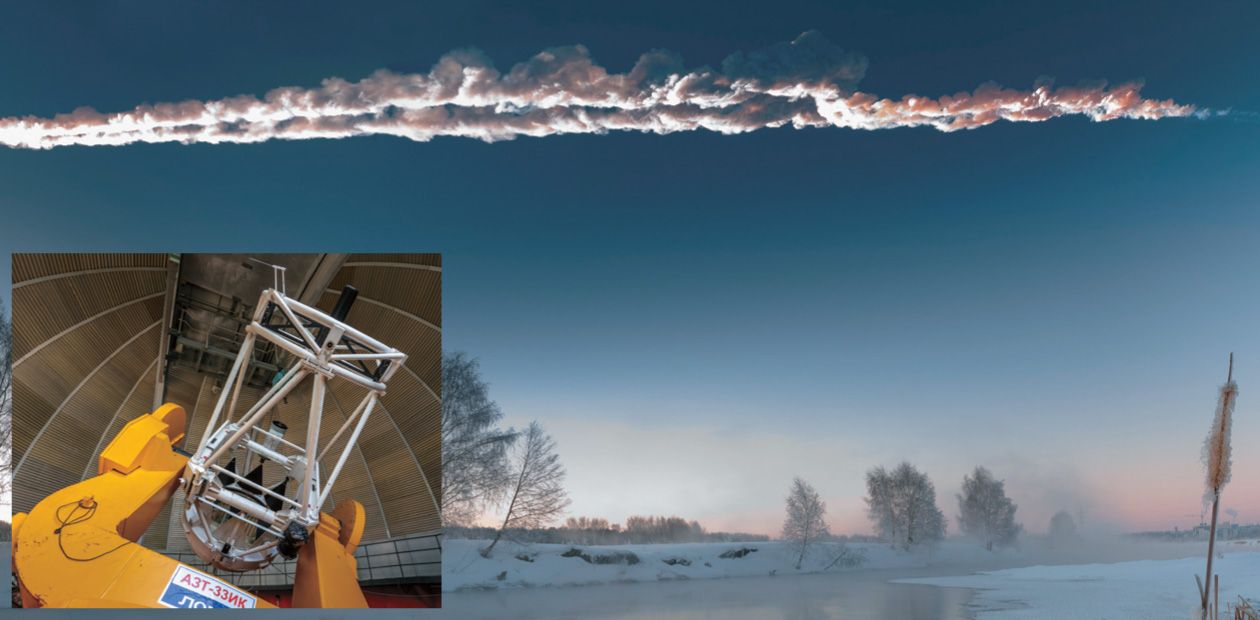The Echo of the Chelyabinsk Bolide
On February 15, 2013 an unusual celestial event occurred in the sky above the southern Urals. The shots taken by numerous eyewitnesses as well as mass media and the Internet made this phenomenon a page-one story not only in Russia, but worldwide
A bright bolide appeared in the sky above the Southern Urals at 9.20 a.m. local time. The tailed fireball streaked the blue morning sky from southeast to northwest at a small (approximately 16°) angle to the horizon, leaving a heavy smoke-dust track. The light of the bolide increased to turn into a radiant shine comparable to the sun and ended in a bright flare.
METEOROID is a small celestial body, smaller than an asteroid but considerably larger than an atom, travelling through space.
METEORITE is a meteoroid that reached the Earth’s surface.
METEOR is the flaming tail of a meteoroid flying at a tremendous velocity in the Earth’s atmosphere.
BOLIDE is a very bright and noticeable meteor
For the first time in the modern history of mankind, such a rare celestial event was recorded in detail, concurrently, from many spaced watch points thanks to numerous drive cams. This made it possible to reconstruct in detail the processes that took place during its fall and compare them with the theoretical predictions.
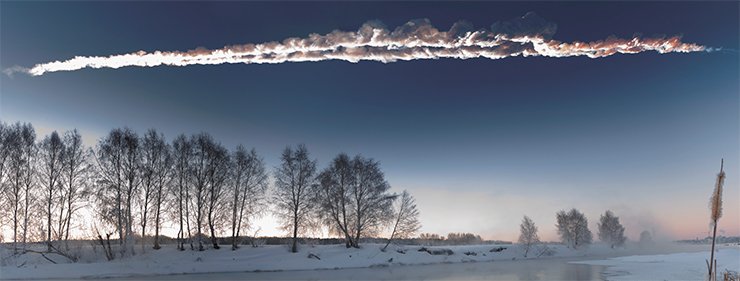
According to the data of the Astronomical Institute, Czech Academy of Sciences, the celestial body entered the atmosphere at a height of 91 km. Czech researchers and NASA experts estimated the initial velocity of the meteoroid on entering the atmosphere as 17.5–18 km/s.
Nine seconds later, at an altitude of 41 km, the body started to disintegrate: according to the computations, by that moment the pressure of the airstream had reached about 40 atm. Two seconds later, the brightest flash took place at an altitude of 23 km.
The celestial body started to disintegrate over the village of Belousovo near Lake Bol’shoi Shantrapai (Etkul’ District, Chelyabinsk Oblast) at a height of 41 km and exploded at a height of 23 km, approximately 40 km southeast from the center of Chelyabinsk. The village of Pervomaiskii was the closest to the ground zero.
The total projection of the Chelyabinsk meteoroid trajectory exceeded 300 km; its fragments fell into Lake Chebarkul’ (near the city of Chebarkul)
The bolide was observable on a vast area, including the Tyumen, Chelyabinsk, and Sverdlovsk oblasts as well as Northern Kazakhstan and Bashkortostan. This celestial event appeared to be exclusively powerful. Based on the infrasound generated by the bolide and measured by the network of earth stations, NASA experts published hot model computation results. The total energy released as a result of the meteoroid destruction was estimated as 0.3—0.5 megatons TNT equivalent; initial mass, 10 000 tons; and size, up to 17 m.
From Vitim to Chelyabinsk
The destruction of celestial bodies in the atmosphere is an intricate and multistep process. Owing to intense airstream pressure and high temperatures, the stone body starts to crack, burst, split, and disintegrate already at high altitudes. At a certain height, the emerging thermal stresses exceed the strength of flying fragments, which leads to the so-called thermal explosion of the meteoroid. As a result, the fragments crush to the size of rock stone and even coarse sand, most of which evaporate in an explosive manner in the incandescent gas (plasma) cloud that surrounds the swarm of flying fragments. Typically, this takes place at heights of about 30 km. Indeed, the brightest flash in our case was observed to the south of Chelyabinsk at an altitude of 32 km.
In the explosion, some fragments change their trajectories; the fragments that separated slightly earlier succeed in efficiently slowing down owing to air friction and do not turn into dust. As a result, the swarm of flying fragments, in addition to finest particles, dust, and sand grains, may contain small stones and even larger fragments scattering in a fan-shaped manner. The largest fragments fly away farthest by inertia, while the small ones rapidly lose their velocity and fall down earlier.
There is some indirect evidence that a comparatively large (weighing several dozens of kilos) fragment of the Chelyabinsk bolide fell into Lake Chebarkul’, breaking through the ice. Individual small meteorite fragments, with weights from one gram to 1.8 kg, were found in snow near the trajectory of the fall.

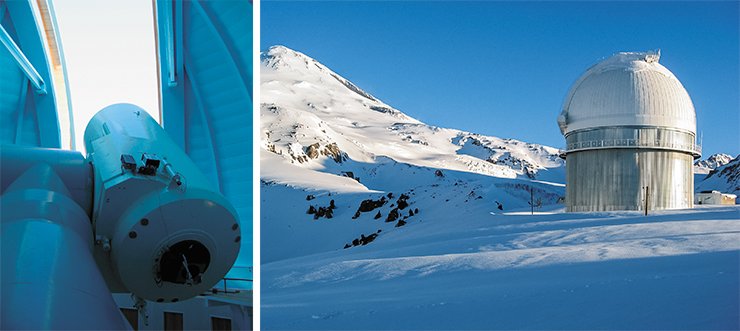
The flight in the atmosphere of a large body at a cosmic velocity generates a strong blast wave. The blast wave that emerged from the explosion of the Chelyabinsk meteorite came several minutes after the flash and destroyed window frames and light building constructions as well as broke the window panes, 200,000 square meters in area. Totally, about 7,300 buildings were damaged and over 1,100 people were injured (some of them, heavily) by glass fragments. As a result, the city of Chelyabinsk reported losses of a billion roubles.
It should be mentioned that since the beginning of the 21st century three similar celestial events have been observed in Russia, whose area constitutes just about 3% of the global surface. In particular, the famous Vitim bolide shone in the sky in the north part of the Irkutsk Oblast during the night of September 25, 2002; its force was estimated as 2,500 tons TNT equivalent. The size of this stone meteorite, which turned into dust, had been approximately 3 m, the weight being about 50 tons. The blast wave, which came from a height of 32 km, broke tree tops and caused partial forest fall along the trajectory of the bolide fall.
A bright bolide accompanied by powerful acoustic and light phenomena was observed in the Republic of Komi on October 17, 2009. On March 01, 2011, a large bolide accompanied by a blast wave and a vapor condensation trail was observed and recorded with a mobile phone in the Osa District, Irkutsk Oblast, Russia.
Luckily, all the three meteorites impacted on the Earth far away from densely populated areas. The Chelyabinsk super-bolide was the first and, fortunately, the only event in recent history when a comparatively large celestial body fell near a heavily populated city, causing rather severe damages. The fact that there were no victims should be regarded as a fantastic bit of luck.
Why was there no alert?
Immediately after the impact of the Chelyabinsk meteorite, the mass-media space of Russia exploded with agitated questions why there was no alert and where were the EMERCOM as well as the air defense and missile shield service.
Indeed, no observation system predicted or noticed the approach of this celestial “messenger” to the Earth, so it came as a total surprise to everyone. However, the question is whether it is feasible at all to detect beforehand a small asteroid heading for the Earth.
Currently, almost 20 observation programs are active worldwide, under which the “fresh” images of an area of the star sky are compared with the existing star maps saved in computers. This allows for discovering new objects previously absent in databases.
First and foremost, note the actively working observation systems of the United States, namely Spacewatch-1 and 2, LINEAR, LONEOS, NEAT, Catalina Sky Survey (CSS), Siding Sky Survey (SSS), Mount Lemmon Survey (MSS), and AMOS. The Canadian Victoria, Swedish-German UDAS, Italian-German ADAS, Czech KLENOT and KLET, the Chinese system with the Beijing Observatory, and Ukrainian system with the observatory on Mt. Simeiz are more modest contributors to these global projects. Finally, there is the Russian contributor comprising the observatory with the Institute of Astronomy (Russian Academy of Sciences, Zvenigorod) and the network of MASTER telescopes (Mobile Automated System of TElescope Robots), launched on the initiative of Sternberg Astronomical Institute with Lomonosov Moscow State University. This list includes mainly smaller telescopes with a mirror diameter of 0.5–1.8 m.
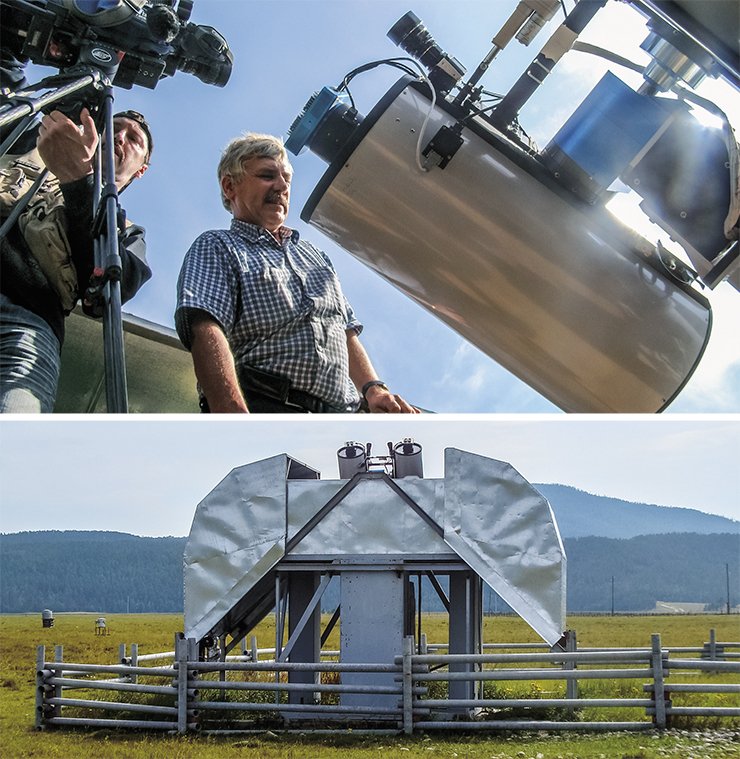
For example, the MASTER-2 component installed on the Buryat test site of Irkutsk State University has recorded 27 observations of 11 asteroids heading for the Earth, which provided more detailed parameters of their trajectories. Two new asteroids were discovered by this network in 2011, and two more, in 2012. In fact, these two objects are located in the Major Asteroid Belt and do not come close to the Earth.
However paradoxical it may seem, the MASTER system demonstrated its considerable capabilities exactly on February 15, 2013 – on the very day of the Chelyabinsk impact. On that day, asteroid 2012 DA14, discovered a year earlier, was expected to pass at a distance of 26,900 km from the Earth. MASTER-2 – Amur (Blagoveshchensk) monitored this asteroid for several hours against the background of starry sky and made high-quality images
The joint efforts have made it possible to detect about 10,000 asteroids approaching Earth, and their number increases by one to three objects per day. Note that the number of known large (ranging from several hundred meters to several kilometers) objects grows much slower. This means that most of such asteroids have already been discovered, which is not surprising, since large asteroids are better detectable and can be observed many months and even years before they come closer to our planet. As for small asteroids, it is not so easy to detect them.
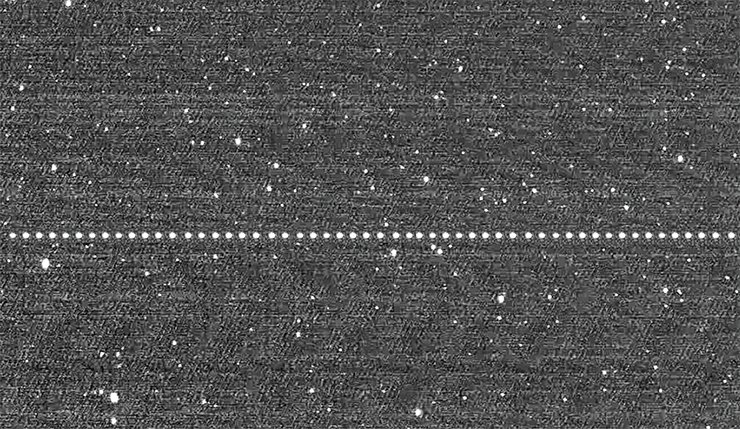
First, sensitivity of the majority of working systems with a small (less than 1 m) lens diameter is rather moderate; correspondingly, asteroids with a size of several meters are detectable not earlier than only few days or even hours before they approach the Earth. Over the entire history of observations there has been only one precise prediction of an event for a celestial body impact: this was a small meteoroid detected less than 24 h before its destruction over a desert in Sudan on October 7, 2008.
Second, all the existing observation systems cannot boast of absolute efficiency, which was clearly demonstrated by the Chelyabinsk bolide. There is no doubt that many space objects flying near the Earth just pass by unnoticed. If such an object approaches the Earth from the direction of the Sun, it is simply impossible to detect it in the day sky with the help of a terrestrial telescope. In addition, the field angle of a typical telescope is, as a rule, very small; so many clear nights are necessary to examine all the sky. Otherwise, it is impossible to “pinpoint” an approaching asteroid beforehand. To solve this problem it is necessary to have both a large number of small telescopes concurrently examining different sky segments, and large telescopes with a diameter of their lenses about 10 m and a large field angle.
It is also evident that a search for the celestial bodies threatening the Earth is not an appropriate task for people: this method of observation is not reliable. This is why most of the above listed systems are based on automated networks of small telescopes. One of the most reliable systems in this area is the United States–Australian Catalina with mirror diameters of 0.5 to 1.5 m. The Russian MASTER network, mentioned above, is also completely automated.
Outlook for the future
It is known that the higher the collecting area of the principal mirror, the better is the sensitivity of a telescope. However, as has been noted above, typical optical schemes have a small field angle; thus, examination of the accessible sky region requires many months and even years. Therefore, a topical current challenge is to create wide-angle telescopes with a comparatively large aperture (the diameter of the principal mirror or the collecting lens).
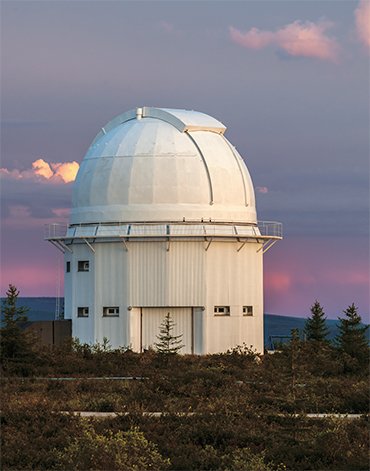 The first Pan-STARRS (United States) telescope with a mirror diameter of 1.8 m, which was put in operation in Hawaii in 2007, had an unusually wide field of vision (3 square degrees). Later, four such telescopes were united into one system (this scheme had been worked out for a laser range-finder for military purposes). Several such systems are planned to be constructed.
The first Pan-STARRS (United States) telescope with a mirror diameter of 1.8 m, which was put in operation in Hawaii in 2007, had an unusually wide field of vision (3 square degrees). Later, four such telescopes were united into one system (this scheme had been worked out for a laser range-finder for military purposes). Several such systems are planned to be constructed.
Perhaps, the most impressive is a United States project, the Large Synoptic Survey Telescope (LSST), with a main mirror diameter of 8.4 m. A wide field of this telescope will be achieved by using three mirrors: its optical scheme includes two additional mirrors of 3.4 and 5.0 m in diameter. The camera of the telescope will comprise 180 digital matrices, totally containing about three billion pixels. The information content of each image taken by this telescope will reach one terabyte. It is natural that such enormous information flows will require new data management technologies.
The LSST launching is scheduled for 2016. The telescope will be located on El Peñón Peak of Mt. Cerro Pachón (2682 m) in the northern part of Chile. It is expected that the new telescope will be able to examine all the sky over several nights.
Immediately after the impact of the Chelyabinsk super-bolide, acceleration in developing the Space Situational Awareness (SSA) system was announced; this European system, launched by the European Space Agency in 2008, is intended for searching and observing the most dangerous asteroids. Under this project, the construction of a system comprising six wide-angle telescopes with a mirror diameter of 1 m is planned in near future; the system will be able to detect potentially dangerous asteroids larger than 50 m in diameter 3 months before they might impact on the Earth.
In Russia, the currently working large telescopes are few, and they were not intended to monitor asteroids. Among them are the six-meter telescope of the Special Astrophysical Observatory with the Russian Academy of Sciences (RAS) near the village of Arkhyz; two-meter telescope on Terskol Peak (Zeiss-2000, Terskol Branch of the Institute of Astronomy, RAS); 1.7-meter telescope of the Sayan observatory with the Institute of Solar-Terrestrial Physics, Siberian Branch, RAS (Irkutsk); and Russian–Turkish 1.5-meter telescope located near Antalya (Turkey), constructed on the initiative of Kazan Federal University. In addition, there is one military device located in the Altai region (Zmeinogorsk).
Today in Russia, new systems with quite large apertures are created only at the Institute of Solar-Terrestrial Physics. In particular, an AZT-33 survey telescope with a 1.6-meter mirror and a wide field angle (about 3 square degrees) is under construction in the Sayan observatory of this institute near the Mongolian border. This telescope designed by the Leningrad Optical–Mechanical Association (LOMO) will be launched in the nearest future.
V.M. Lipunov, Professor of Moscow State University and Head of the MASTER project, proposed creating a network of modified telescopes, MASTER-3, intended for monitoring the asteroid and comet threats. This project is based on the already existing infrastructure and thus can be implemented within a short time span, using relatively limited funding.
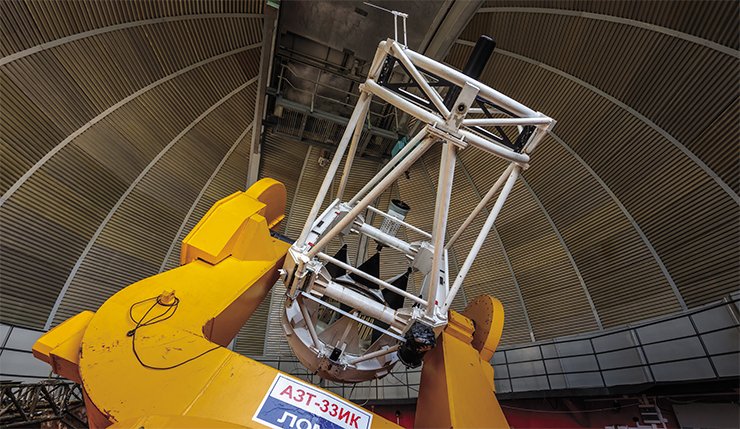
Note that while the networks of relatively small and inexpensive automated telescopes are being developed both in this country and worldwide, the design and construction of large telescopes with wide field angles require expenditures of hundreds of millions of dollars. For example, the estimated cost for the mentioned unique device LSST, is about 400 million dollars; however its actual cost will undoubtedly be higher.
Until recently, not only governments, but also many scientists regarded the construction of such systems as unwarranted waste of money, and the very danger of such impacts as exaggerated. However, the statistics of discovered asteroids approaching the Earth made many scientists and politicians give a serious thought to this issue. Most likely, many of them will reconsider their opinion owing to the Chelyabinsk event.
What will people do once they know that a certain asteroid is to impact on the Earth? Even if early detection of dangerous asteroids is figured out within several years, this won’t mean being able to avoid the danger.
We have to admit that at present there are no systems able to destroy or inflect an approaching object. Numerous theoretical approaches have been proposed but there is no real technology. Moreover, actually nobody has seriously tackled the development of a system capable of intercepting asteroids. Initiation of corresponding projects requires a political decision, since it is evident that they will demand tremendous resources.
However, there is no doubt that this challenge has to be met. Just recall that the famous Tunguska meteorite caused forest falls over an area of over 2,000 km². It is unthinkable what could have occurred if the trajectory of Chelyabinsk bolide had been slightly closer to the city, although its force was approximately one-twentieth of that of the Tunguska one. Numerous casualties would have been inevitable. Recent astronomical observation data demonstrate that every year dozens of celestial bodies of various sizes come close to the Earth and are detected, at best, several days before. In Russia alone four impacts of super bolides have already been recorded in the century that just began. And what can we say beforehand about the trajectory of an asteroid heading for the Earth, which could possibly be discovered tomorrow?
Indeed, any defense measures cost a lot, but their absence can be much more expensive. As A.V. Bagrov (Doctor of Physics and Mathematics with the Institute of Astronomy of the Russian Academy of Sciences and Leading Specialist with the Lavochkin Research and Production Association) says, a space-borne peril is also a military peril, but coming from the enemy whom you can neither frighten with revenge nor draw into talks. Our defense should be prepared to repel space attacks as if they were military attacks.
There is a chance that the Chelyabinsk “syndrome” will catalyze the already advanced projects focused on the response to asteroid and comet threats, including Russian proposals which are in cold storage in the offices where the decisions are made. Many Russian high-rank politicians have already spoken about the need to seriously address the problem of asteroid threat.
References
Asteroidnaja opasnost’: vchera, segodnja, zavtra. M.: FIZMATLIT, 2010. 384 s.
Bronshtjen V. A. Tungusskij meteorit: istorija issledovanij. M., 2000. 312 s.
Vishnevskij S. A. Astroblemy. Novosibirsk: OOO “Nonparel’”, 2007. 288 s.
Katastroficheskie vozdejstvija kosmicheskih tel / Pod red. V. V. Adushkina i I. V. Nemchinova M.: IKC “Akademkniga”, 2005. 310 s.
Ugroza s neba: rok ili sluchajnost’? / Pod red. A. A. Bojarchuka M.: Kosmoinform, 1999. 220 s.
Cicin F. A. Ocherki sovremennoj kosmogonii Solnechnoj sistemy. Dubna.: Feniks+, 2009, 356 s.
Jenciklopedija. T. 8. Astronomija / Gl. red. M. D. Aksenova. M.: Avanta+, 1997. 688 s.
The editorial board is grateful to the Chelyabinsk Local History Museum for kindly provided photos by M. Akhmetvaleev


